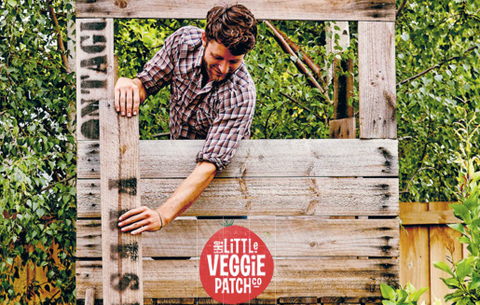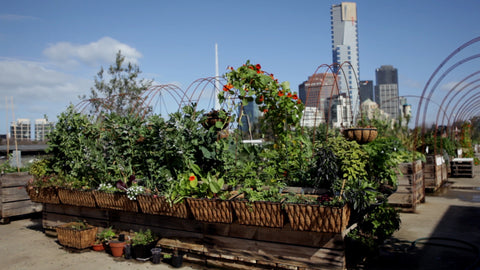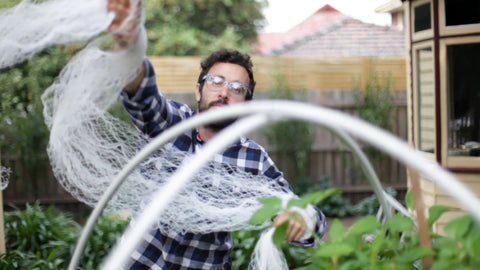Top 10 ways of using an apple crate
The apple crate is one of the great building blocks of life. Along with the milk crate and pallet, it is a material that seems to exist for the DIY project, and we wonder where our business would be without it. Certainly the Pop Up Patch wouldn't have existed if not for the humble apple crate (and its crew of upcycled friends).

We stumbled across the apple crate by chance. When Mat started the business many moons ago he worked as a landscaper on Stephanie Alexander's home. There she had converted an apple crate into what looked like an almost purpose built veggie patch. After a brief chat between the two she was kind enough to give the start up Little Veggie Patch Co a plug in her book - coincidently, alongside where she talked about using apple crates as veggie patches. The phone started ringing and the rest is history.
These days the apple crate is ingrained in our DNA and while we think it is almost perfect, it is more than open to some simple alterations.
1. Create self watering wicking beds: what part of “self watering” doesn’t sound appealing? That’s right, using the age old idea of capillary action, water is drawn from a reservoir below up into the soil where the plants decide when to use it. Can you remember your science teacher dipping a tissue into a glass of water? Well the water travelling against gravity up its fibres is capillary action. The same process is in action in a wicking bed. Other than the self watering function, wicking beds keep the soil more insulated and with a layer of mulch added to the surface, water is only ever lost when being used by the veggies. These systems are so much more suited to today’s time poor, aspiration rich food grower.
2. Convert into part herb planter, part seat: a veggie crate doesn’t just have to be a square wooden box. Maybe you need some seating to show off your new hat and half as a herb patch is sufficient. With some simple alterations a full sized crate can be converted into a herb seat planter.

3. Make mobile with castors: in this fast paced life the ability to be portable and on the move in a split second is absolutely essential. Imagine you’ve just been invited to a dinner party and you don’t have time to pick up a dish from the store. The answer: portable veggie crate! Don’t have credit to catch an Uber either, again the answer: portable veggie crate! Dinner parties and uber rides aside, having your veggie patch mobile means it can be moved to make space for when you’re entertaining. Considering we’re all living in smaller and smaller spaces, the ability to shuffle things around when necessary is always helpful.

4. Build a cubby house: sometimes kids don’t have the attention spans to wait for the veggies to grow and so we need to lure them out into the garden. Thankfully the veggie crate is the ultimate building material and even those with moderate handiness can turn square boxes into feats of grand design. We’ve built cubby houses to rival the main dwelling and positioning it amongst the garden means the veggies can’t be avoided.

5. Cut down for kids: give the little ones access to the patch by cutting down the height of the crates. Sure it means that some carrots and spring onions may go missing, but it also means they are more engaged in the growing process and in time those vegetables will have all the help they need to flourish.

6. Accessorise to maximise your real estate: often ground level real estate is so precious that there’s never enough room to realise all your growing dreams. It may be time to accessorise. The great thing is that a veggie crate can be considered a simple dwelling, and renovations and extensions don’t require a lot of handiness nor building approval. Hanging baskets, internal trellises, a second granny flat are all simple additions that will add a lot of value to the property. This is how Lisa and Roy maximised their rent at Pop Up Patch.

7. Net for maximum security: the dreaded netting. If you’re like us the only thing that can truly destroy a beautiful veggie garden is an ugly, cumbersome netting. But unfortunately that’s not right. There are other things that can destroy a veggie patch, such as birds, possums, caterpillars, rats and of course, children. All of these things can be deterred or prevented with a soundly constructed netting.

8. Connect with an arbor: we remember spending hundreds of dollars and dozens of hours building an arbor between two crates using bamboo. Shortly after we found concrete trench mesh and in 5 mins and a fraction of the price we achieved the same result (some say a better one). Connecting a couple of veggie crates with an arbor not only presents a passage way to your garden, but gives a meaningful trellis on which a variety of plants can grow.

9. Give it a name: would you feel as connected to your pet if it didn’t have a name? So why not develop a better relationship with your veggie patch and give it a name too. Building ownership in the garden is a great step towards growing a successful veggie patch and gives you the opportunity to show your friends how funny you are by naming it Thyme after Thyme or The Shovel and a Bunch of Hoes or our personal favourite, The Veginator
10. Just grow food: sometimes it’s easier to make excuses than to jump right into something. Much like spending years writing the business plan for the business that will never see the day of light. Vegetable gardening can seem a bit daunting and it’s natural to find reasons not to get started, but it’s a trial and error, fail and then succeed process that is like anything else in life. Except you quickly realise it’s easy, satisfying and highly addictive. Our veggie crates are the perfect starting point because they’re readymade and affordable. We’ve been doing the trial and error for so many years that we feel we’ve perfected the organic recipe. Just add water!

-
Posted in
infrastructure

